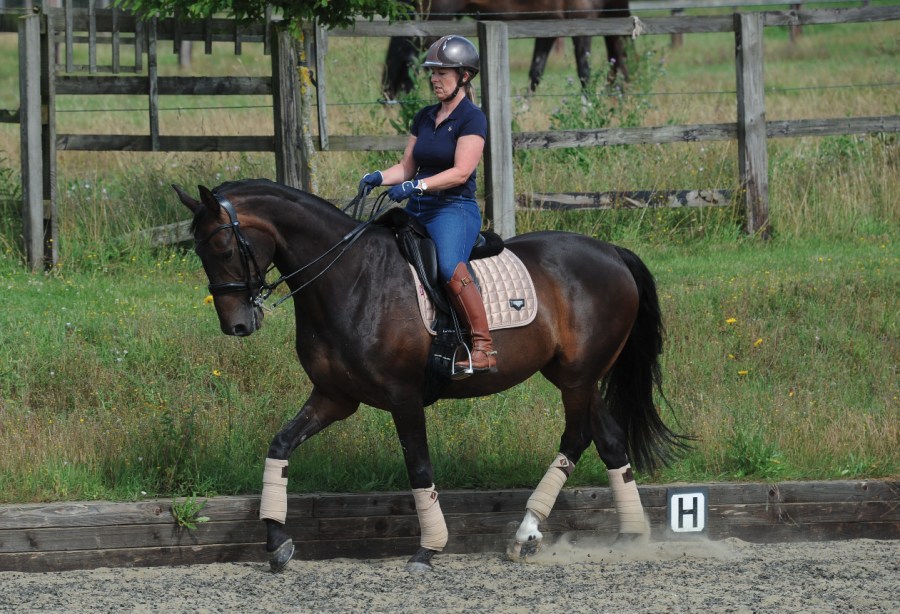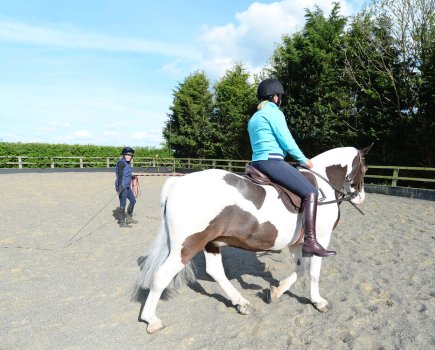Ensuring that your horse is in front of the leg will not only improve your performance, but also make them a better horse to ride. Irish eventer Austin O’Connor shares three exercises to get your horse sharper off the aids.
I use these exercises as part of my everyday training and they’re a great test to see whether your horse is genuinely on your aids and listening to your seat and leg.
The most crucial aspect of these three exercises is that your horse remains in front of your leg. If they’re finding the exercises hard, then look for quality rather than quantity.
Be sure to adapt them according to ability and age and always give plenty of walk breaks in between, as warming up and cooling down.
Exercise 1: Lateral work to improve aids
Time: 10 minutes
Teaching your horse to move away from the leg is just as crucial for everyday riding as it is for jumping around Badminton. Your horse needs to know how to move away from your inside leg to your outside rein.
This exercise is something that I teach all of my horses and incorporate into my daily work at home. I like to teach the horses to leg yield from the inner track to the outer track as they naturally gravitate to the fence line.
How to ride it:
- In working trot, go large around your arena, then turn down the three-quarter line. Ride a few strides of trot in a straight line, then do a half-halt and ask your horse to move over from your inside to your outside hand.
- If your horse is green or inexperienced, or doesn’t understand what it is you’re asking, don’t be afraid to open out the outside rein and encourage them to move over. At this stage, you just want to get them to understand what you want them to move across.
- If your horse is more experienced, ride the leg yield with an outside contact and concentrate on maintaining straightness. Ride a few steps of leg yield, go straight for a couple of steps, then leg yield again. This keeps your horse straight and encourages them to think forward.
Top tip: Don’t nag constantly with your leg. If your horse isn’t reacting, go back to basics and get them responsive to your leg aids.
The next step: Riding leg yield on a circle, spiralling in and out of the centre of the circle, is also a really useful training exercise.
Exercise 2: Improving rhythm with poles
Time: 10 minutes
I use canter poles in a lot of my work. This exercise is not only good for the rider’s eye, but also super for promoting balance and rhythm in the horse and helping to develop the quality of the canter.
If your horse can’t canter rhythmically over poles, then you’re going to have an issue when the poles are replaced by a course of fences.
Set it up: Set out four poles in a straight line – five canter strides between the first two poles, six between the next pole, seven strides to the last.
How to ride it:
- Keep your horse straight and in front of your leg, but focus on keeping the same rhythm around the whole arena.
- If your horse finds lots of canter poles exciting, then just put out one or two around the arena and slowly build up.
- Play with the distance to shorten or open up the canter stride.
Exercise 3: Time to stretch
Time: 10 minutes
Never underestimate the value of teaching your horse to stretch. It’s vital for all horses and should be an essential part of your training. Most will offer a better stretch after they’ve worked.
How to ride it:
- In rising trot, on a 20m circle, put your hands forward a little and see if your horse follows the contact. If they are seeking more stretch then allow them more rein, but don’t throw away the contact.
- You want to keep that connection with your horse’s mouth, but don’t be tempted to allow them too much rein so that they snatch for more length and then come up and hollow through their back.
- This can be a surprisingly difficult exercise for some horses, so build up the length of rein as your horse becomes more confident. You need to ride this exercise with the emphasis on maintaining suppleness, softness and rhythm.
- Eventually you should be able to allow your horse to stretch at intervals during your training sessions, then pick up the contact for work again, still keeping that same softness and rhythm.
Meet the expert: Eventer Austin O’Connor has represented Ireland twice at the Olympics. A familiar face at 5 horse trials and on the international eventing circuit, he also teaches riders of all levels.









